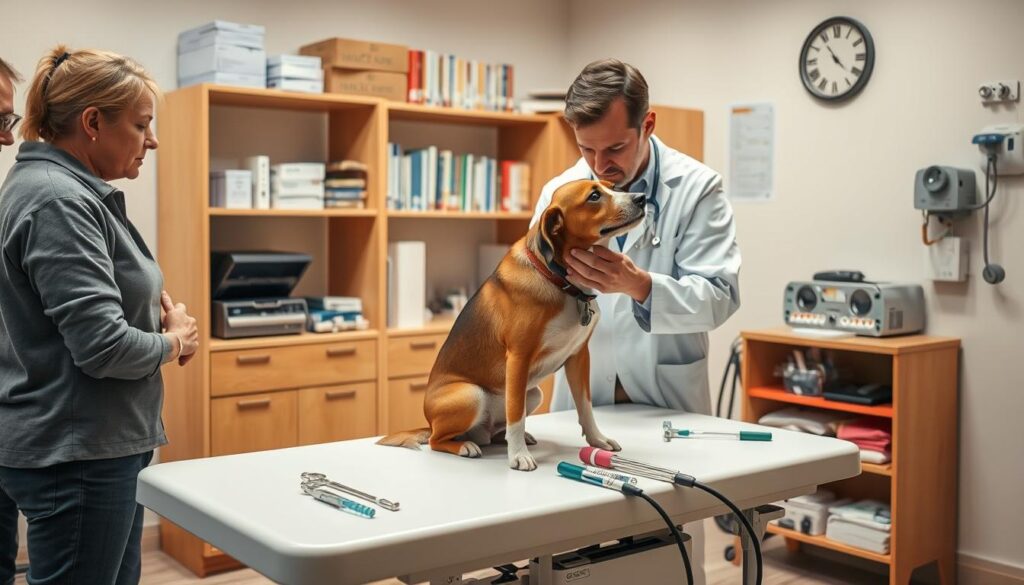How Do You Know if Your Dog Is Special Needs? Key Signs
Every dog is special in their own way. Some need more care and attention than others. Figuring out if your dog has special needs can be tough for pet owners.
Some dogs face physical or neurological challenges. These can affect their daily life. Your love and understanding can help them a lot.
Dogs with special needs offer a chance to bond deeper. By recognizing signs early, you can create a supportive home. This helps them live their best life.
This guide will show you how to spot special needs in dogs. We’ll look at behavioral and physical signs. These can tell you if your dog needs extra care and attention.
Table of Contents
Understanding Special Needs in Dogs: An Overview
Dogs, like humans, can have special conditions that affect their daily lives. If you wonder if your dog is autistic, it’s important to know about canine special needs. An autistic dog may act differently than other dogs.
Special needs in dogs cover a wide range of conditions. These need special care and understanding. They can show up in different ways, like physical, behavioral, or neurological symptoms.
Types of Special Needs Conditions
- Neurological disorders
- Developmental challenges
- Sensory processing differences
- Cognitive function variations
- Genetic predispositions
Impact on Daily Life
For dogs with special needs, daily life is different. They might find it hard with:
- Social interactions
- Routine changes
- Sensory stimulation
- Learning and training
Common Misconceptions
Many pet owners don’t understand special needs dogs. Not all behavioral differences mean a serious condition. Getting a vet’s professional assessment is the best way to understand your dog’s needs.
Every dog is unique, and understanding their individual needs is key to providing the best care possible.
How Do You Know if Your Dog is Special Needs
Figuring out if your dog has special needs takes careful watching and knowing their unique behaviors. Dogs can’t be diagnosed with autism like people, but they might show signs that suggest they’re different.
To know if your dog has special needs, look for certain signs. These include:
- Unusual social interaction patterns
- Challenges with environmental adaptability
- Repetitive or compulsive behaviors
- Heightened sensory sensitivities
Autism in dogs might show up in how they communicate. Your dog might:
- Not make eye contact
- Not respond well to commands
- Have trouble understanding social cues
- Like to be alone more
| Behavioral Indicator | Potential Special Needs Sign |
|---|---|
| Repetitive Actions | Potential Neurological Difference |
| Sensory Overstimulation | Possible Developmental Variation |
| Social Interaction Challenges | Indicative of Neurodevelopmental Traits |
Getting a professional vet’s opinion is key to really understanding your dog’s needs.
Recognizing Behavioral Signs of Autism-Like Traits
Figuring out if dogs can have autism means watching their behavior closely. Even though vets are still learning about dog autism, some signs might point to it.
Dogs showing autism-like traits often act differently. They might show unique behaviors that stand out from usual dog actions. These signs can help owners spot possible neurological differences.
Social Interaction Challenges
Looking at signs of autism in dogs, trouble with social interactions is key. Your dog might:
- Not want to play with other dogs
- Avoid eye contact or getting close
- Not respond well to social cues from people or animals
- Seem uncomfortable in groups
Repetitive Behaviors and Routines
Yes, dogs can have autism-like repetitive behaviors. Look out for these signs:
- Spinning or circling in the same way
- Getting stuck on certain objects
- Doing the same movements over and over
- Being very upset by changes in their routine
Sensory Sensitivities
Dogs with autism-like traits might be more sensitive to their senses. They could react strongly to:
- Very loud noises
- Particular textures or touch
- Bright lights or visual stuff
- Unexpected changes in their environment
Keep in mind, these signs don’t mean your dog definitely has autism. Getting a vet’s opinion is key to understanding your dog’s unique brain.
Physical Indicators of Special Needs Dogs

Figuring out if your dog has special needs starts with noticing certain physical signs. Small dogs are especially at risk for conditions that need quick attention.
When looking for signs of special needs in dogs, both vets and owners should watch for a few important traits:
- Unusual body structure or congenital deformities
- Persistent mobility challenges
- Visible neurological impairments
- Chronic medical conditions affecting physical development
Some signs that might mean your dog has special needs include:
| Physical Indicator | Potential Significance |
|---|---|
| Limb deformities | Potential genetic or developmental issues |
| Abnormal gait or movement | Possible neurological or muscular challenges |
| Vision or hearing impairments | Sensory processing difficulties |
| Chronic skin conditions | Underlying health complications |
Regular vet visits are key for catching special needs early. Your vet can do detailed checks and help manage your dog’s unique needs.
Always be kind and get expert advice when you notice physical signs. This way, your dog gets the right care and support.
Neurological Signs and Symptoms to Watch For
Spotting neurological problems in dogs can be tough, especially if you wonder if they might have autism-like traits. Small dogs are more likely to face these issues, affecting their health and behavior.
To figure out if your dog has autism, watch for neurological signs that point to special needs or different thinking.
Movement and Coordination Challenges
An autistic dog might move in ways that are not typical for dogs. Look out for:
- Uneven walking or constant circling
- Hard time staying balanced
- Odd gait or stiff legs
- Problems with knowing where things are
Cognitive Function Changes
Changes in how they think can also show up. Keep an eye for:
- Not responding to commands as well
- Struggling to learn new things
- Doing the same things over and over
- Being very sensitive to their surroundings
Seizure Activity
Seizures are a big sign of possible special needs. Look for:
| Seizure Type | Characteristics | Potential Risk |
|---|---|---|
| Focal Seizures | Localized muscle twitching | Moderate |
| Generalized Seizures | Full body convulsions | High |
| Absence Seizures | Momentary loss of awareness | Low |
Spotting these signs early can help you support your autistic dog better. This ensures they get the care and understanding they need.
The Role of Professional Diagnosis

Figuring out if dogs can have autism or show symptoms like it needs a detailed check-up. Vets are key in spotting neurological and behavioral issues that might look like autism in dogs.
The steps to diagnose autism in dogs include:
- Detailed behavioral history assessment
- Comprehensive physical examination
- Neurological screening
- Ruling out alternative medical conditions
Your vet will watch how your dog acts with others, repeats actions, and reacts to sounds and sights. Animal behaviorists with special skills might also help understand your dog’s brain and behavior better.
| Diagnostic Approach | Purpose |
|---|---|
| Behavioral Assessment | Evaluate social interaction patterns |
| Physical Examination | Check neurological function |
| Advanced Imaging | Identify potential brain structure differences |
“Early professional diagnosis can significantly improve management and quality of life for dogs with special needs.” – Dr. Karen Brown, Veterinary Neurologist
Getting a professional diagnosis is crucial. It helps tell real brain problems from just bad behavior. Your vet will use a careful method to make sure they get it right and find the best way to help your dog.
Supporting Your Special Needs Dog
Having a dog with special needs means you need to create a supportive home. Knowing if your dog is special needs helps you care for them better. Whether they face neurological challenges or show autistic traits, making changes can greatly improve their life.
Caring for a special needs dog takes patience, creativity, and planning. Your dedication can make their daily life better and help them feel loved and secure.
Creating a Safe Home Environment
To make a safe space for your special needs dog, follow these steps:
- Remove hazards from their path
- Use padded flooring for mobility issues
- Install baby gates to block dangerous areas
- Make quiet, comfy resting zones
Establishing Consistent Routines
Dogs with special needs love routine. Create a daily plan with:
- Set feeding times
- Regular medication
- Predictable walks and bathroom breaks
- Calm evening routines
Adaptive Equipment and Tools
| Equipment Type | Purpose | Recommended For |
|---|---|---|
| Orthopedic Dog Bed | Supports joints | Dogs with mobility issues |
| Mobility Harness | Helps with walking | Dogs with muscle weakness |
| Anxiety Wrap | Reduces anxiety | Autistic or anxious dogs |
| Non-Slip Socks | Improves grip | Dogs with neurological issues |
Every special needs dog is different. Watch what your dog needs and adjust your care. Talking to vets can give you advice tailored to your dog’s needs.
Treatment Options and Management Strategies
Understanding if your dog is autistic or has special needs is key. Dogs with unique conditions need care that fits their needs. This care should tackle their specific challenges.
Medical help is important for special needs dogs. Vets may suggest treatments to make your dog’s life easier. Can dogs have autism? While not diagnosed like humans, dogs can show autism-like traits that need special care.
- Medication Management
- Pain relief medications
- Anti-inflammatory drugs
- Neurological condition treatments
- Behavioral Therapies
- Specialized training techniques
- Sensory integration approaches
- Cognitive behavioral modifications
Physical therapy and rehab are also vital. They help improve your dog’s movement and strength. Custom exercises and therapy can boost your dog’s abilities.
Other treatments like acupuncture and massage can also help. Working with vet specialists ensures your dog gets the right care. This care is tailored to their needs.
“Every special needs dog deserves a personalized care plan that addresses their individual challenges and strengths.”
Remember, watching your dog closely, being patient, and using flexible strategies are crucial. They help your special needs dog on their journey.
Quality of Life Considerations
Having a dog with special needs means you must focus on their quality of life. It’s important to recognize autism in dogs and know how to support them. This can greatly improve their well-being.
There are several key things to consider when assessing your dog’s quality of life:
- Pain management and comfort levels
- Ability to perform basic daily functions
- Mental stimulation and engagement
- Social interaction and emotional state
Dogs with special needs need extra care to stay happy and comfortable. Veterinary professionals suggest regularly checking your dog’s physical and emotional health. This includes watching how they:
- Eat and drink on their own
- Move without pain
- Keep themselves clean
- Enjoy activities they used to love
At times, you might have to make tough choices about their care. Your vet can help decide if treatments are helping or causing more stress.
Remember, special needs dogs can have a great life with the right support and care. Each dog is different, and their needs will guide how you help them live their best life.
Building a Support System for Special Needs Dogs
Caring for a dog with special needs can be tough. It’s important to have a strong support system for both you and your dog. Veterinary experts, support groups, and special resources can help a lot.
To find the right support, follow these steps:
- Connect with specialized veterinarians who understand autism-like behaviors in dogs
- Join online communities dedicated to special needs pet owners
- Attend local support group meetings
- Seek professional behavioral training consultation
Understanding if dogs can have autism needs expert help. Veterinary behaviorists offer crucial advice. They help you understand your dog’s needs and how to manage them.
| Support Resource | Benefits | Accessibility |
|---|---|---|
| Online Support Groups | 24/7 Community Support | High |
| Veterinary Specialists | Professional Diagnosis | Moderate |
| Behavioral Training | Customized Intervention | Variable |
Your hard work and a good support system can greatly improve your dog’s life. Remember, you’re not alone in this journey.
Conclusion
Figuring out if your dog has autism needs careful watching and expert advice. Spotting signs early can greatly improve your pet’s life. Each dog with special needs is a unique friend who needs love and special care.
It’s key to understand your dog’s specific issues. A vet’s help is the best way to move forward. Knowing about their behavior, how they react to sounds, and their brain health helps you make their life better.
Dealing with special needs dogs takes time, learning, and endless love. Your efforts to help them, whether with autism-like traits or other health issues, really matters. Get help from vets, join support groups, and always try to understand what your dog needs.
Every special needs dog has a lot to offer. With the right help, tools, and care, they can live a happy and meaningful life. Keep learning, watch closely, and always ask for vet advice if you think your dog needs extra help.







